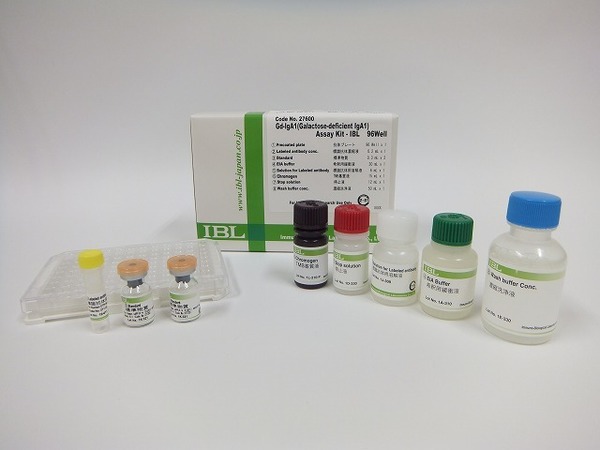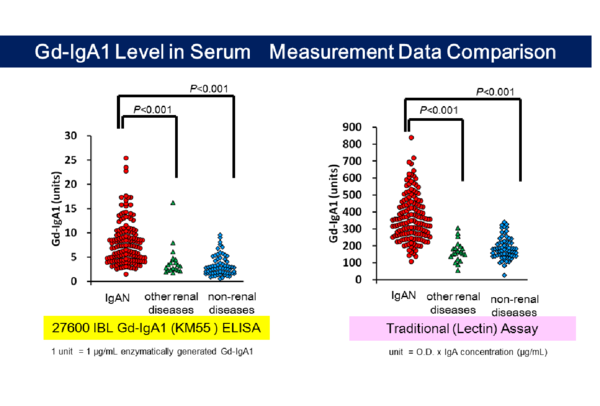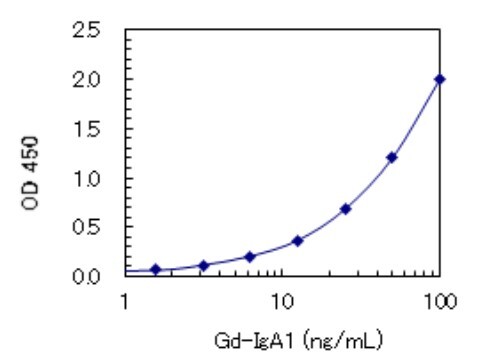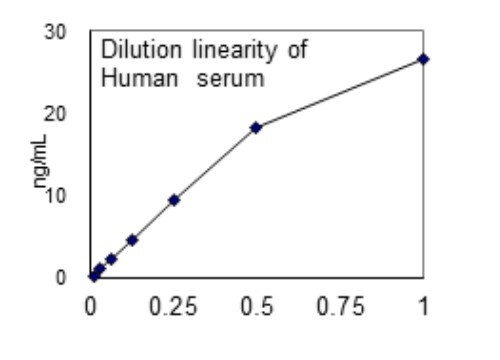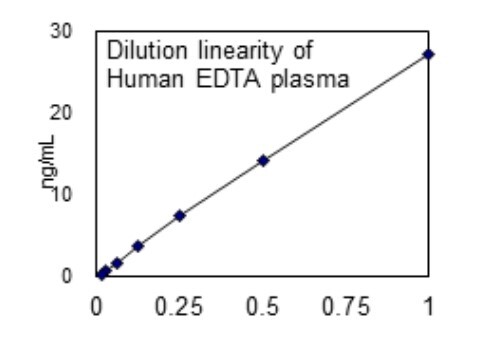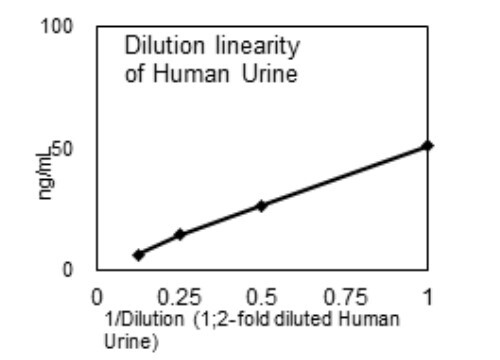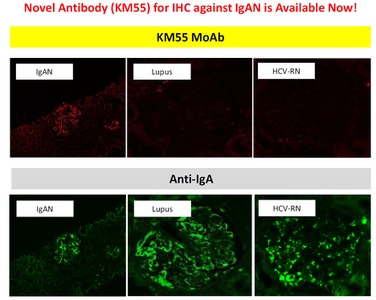- HOME >
- For Researchers >
- Product Search >
- Search Result >
- #27600 Gd-IgA1 (Galactose-deficient IgA1) ELISA Kit - IBL
Product Search
#27600 Gd-IgA1 (Galactose-deficient IgA1) ELISA Kit - IBL
- Intended Use:
- Research reagents
- Measuring Method:
- ELISA
- Sample Types:
- Human
- Measuring Samples:
- Serum, EDTA-plasma and Urine
- Measurement Range:
- 1.56 ~ 100 ng/mL
- Package Size1:
- 96 Well
※ The product indicated as "Research reagents" in the column Intended Use cannot be used
for diagnostic nor any medical purpose.
※ The datasheet listed on this page is sample only. Please refer to the datasheet
enclosed in the product purchased before use.
Product Overview
Product Overview
| Product Code | 27600 |
|---|---|
| Product Name | Gd-IgA1 (Galactose-deficient IgA1) ELISA Kit - IBL |
| Maker Name | Immuno-Biological Laboratories Co., Ltd. |
| Intended Use | Research reagents |
| Measuring Method | ELISA |
| Conjugate | HRP |
| Species | Human |
| Measuring Samples | Serum, EDTA-plasma and Urine |
| Measurement Range | 1.56 ~ 100 ng/mL |
| Primary Reaction | 60 minutes at room temperature |
| Secondary Reaction | 30 minutes at room temperature |
| Sensitivity | 0.488 ng/mL |
| Storage Condition | 2~8°C |
| Poisonous and Deleterious Substances | Not Applicable |
| Cartagena | Not Applicable |
| Measuring Service | Available |
| Package Size 1 | 96 Well |
Product Description
Product Description
Galactose-deficient IgA1 (Gd-IgA1) attracts a lot of attentions as a critical effector molecule in the pathogenesis and progression of IgA nephropathy (IgAN) in recent studies. It has been suggested that several O-link glycans modified regions exist in the heavy chain hinge region of human IgA1 molecule andGd-IgA1 circulates in blood stream of the patients with the pathological condition of IgAN. The measuring system using snail (helix aspersa; HAA) lectin that is extracted from snail has been used in past numerous studies and it was revealed that serum levels of Gd-IgA1 in patients with IgAN is significantly elevated compared with the level of healthy subjects or patients with renal diseases other than IgAN. Thus, the importance and purpose of measuring serum Gd-IgA1 level have been gradually recognized from such studies.
However, since the measuring system used HAA lectin is not suitable for measuring multiple and massive samples in large scale studies due to its instability of glycan-recognizing activity, development of alternative measuring system that can quantitatively measure human Gd-IgA1 in serum with stable and reliable data has been considered as an essential and urgent matter. This IBL ELISA kit using the monoclonal antibody that specifically recognizes galactose-deficient hinge sequence of human Gd-IgA1 is a lectin non-dependent measuring system that can quantitatively measure Gd-IgA1 in human serum,which is also suitable for large scale studies because of its stability.
However, since the measuring system used HAA lectin is not suitable for measuring multiple and massive samples in large scale studies due to its instability of glycan-recognizing activity, development of alternative measuring system that can quantitatively measure human Gd-IgA1 in serum with stable and reliable data has been considered as an essential and urgent matter. This IBL ELISA kit using the monoclonal antibody that specifically recognizes galactose-deficient hinge sequence of human Gd-IgA1 is a lectin non-dependent measuring system that can quantitatively measure Gd-IgA1 in human serum,which is also suitable for large scale studies because of its stability.
References
References
- The transcription factor HMGB2 indirectly regulates APRIL expression and Gd-IgA1 production in patients with IgA nephropathy. Tian H et al. Ren Fail. 2024 Dec;46(1):2338931.PMID: 38622929
- Effect of Telitacicept on Circulating Gd-IgA1 and IgA-Containing Immune Complexes in IgA Nephropathy. Kidney Int Rep. Zan J et al. Kidney Int Rep. 2024 Jan 10;9(4):1067-1071.PMID: 38765591
- Serum levels of galactose-deficient IgA are elevated in patients with IgA nephropathy but do not correlate to disease activity or progression. Elíasdóttir S et al. BMC Nephrol. 2023 Jun 7;24(1):160.PMID: 37286948
- Safety, Tolerability, Pharmacokinetics, and Pharmacodynamics of VIS649 (Sibeprenlimab), an APRIL-Neutralizing IgG2 Monoclonal Antibody, in Healthy Volunteers. Mathur M et al. Kidney Int Rep. 2022 Feb 8;7(5):993-1003.PMID: 35570983
- cnm-positive Streptococcus mutans is associated with galactose-deficient IgA in patients with IgA nephropathy. Suzuki H et al. PLoS One. 2023 Mar 2;18(3):e0282367.PMID: 36862654
- Racial heterogeneity of IgA1 hinge-region O-glycoforms in patients with IgA nephropathy. Ohyama Y et al. iScience. 2022 Sep 27;25(11):105223.PMID: 36277451
- Zonulin, as a marker of intestinal permeability, is elevated in IgA nephropathy and IgA vasculitis with nephritis. Li Q et al. Clin Kidney J. 2022 Sep 20;16(1):184-191.PMID: 36726446
- Associations between Biomarkers of Complement Activation, Galactose-Deficient IgA1 Antibody and the Updated Oxford Pathology Classification of IgA Nephropathy. Juan YT et al. J Clin Med. 2022 Jul 21;11(14):4231.PMID: 35887995
- Sialylation of IgG inhibits the formation of galactose-deficient IgA1-containing immune complexes and protects mesangial cells from injury in IgA nephropathy. Liu Y et al. BMC Nephrol. 2022 Jan 11;23(1):25.PMID: 35016642
- Proceedings of 16th International Symposium on IgA Nephropathy IgA Nephropathy 2021, 21–23 September 2021 (Virtual).
IgAN: A South-Asian perspective. Page 5.
What biomarkers are on the horizon that may help risk stratify patients with IgAN? Page 45.
Clinical significance of intensity of glomerular galactose-deficient IgA1 deposition in IgA nephropathy. Page 69.
Relevance of serum Gd-IgA1 levels in South Asian IgAN- prospective longitudinal cohort (GRACE-IgANI). Page 74.PMID: N/A - Relationship between Gd-IgA1 and TNFR1 in IgA nephropathy and IgA vasculitis nephritis in children - multicenter study. Mizerska-Wasiak M et al. Cent Eur J Immunol. 2021;46(2):199-209. Epub 2021 Aug 7.PMID: 34764788
- Measurement of galactosyl-deficient IgA1 by the monoclonal antibody KM55 contributes to predicting patients with IgA nephropathy with high risk of long-term progression. Martín-Penagos L et al. Nefrologia (Engl Ed). 2021 May-Jun;41(3):311-320. Epub 2021 Jul 28.PMID: 36166247
- Alternative Complement Pathway Is Activated and Associated with Galactose-Deficient IgA1 Antibody in IgA Nephropathy Patients. Chiu YL et al. Front Immunol. 2021 Jun 10;12:638309.PMID: 34177889
- Clinical significance of serum galactose-deficient immunoglobulin A1 for detection of recurrent immunoglobulin A nephropathy in kidney transplant recipients. Park WY et al. Kidney Res Clin Pract. 2021 Apr 15. Epub 2021 Apr 15.PMID: 33866766
- Clinical Relevance of Serum Galactose Deficient IgA1 in Patients with IgA Nephropathy. Kim JS et al. J Clin Med. 2020 Nov 4;9(11):3549.PMID: 33158064
- Helicobacter pylori infection is associated with elevated galactose-deficient IgA1 in IgA nephropathy. Liu XZ et al. Ren Fail. 2020 Nov;42(1):539-546.PMID:
- Association Between Galactose-Deficient IgA1 Derived From the Tonsils and Recurrence of IgA Nephropathy in Patients Who Underwent Kidney Transplantation. Kawabe M et al. Front Immunol. 2020 Sep 3;11:2068.PMID: 33013875
- TLR7 in B cells promotes renal inflammation and Gd-IgA1 synthesis in IgA nephropathy. Zheng N et al. JCI Insight . 2020 Jul 23;5(14):e136965.PMID: 32699192
- ST6Gal1 is up-regulated and associated with aberrant IgA1 glycosylation in IgA nephropathy: An integrated analysis of the transcriptome. Liu Y et al. J Cell Mol Med. 2020 Sep;24(18):10493-10500. Epub 2020 Jul 17.PMID: 32677771
- Clinical Significance of Serum Galactose-Deficient IgA1 Level in Children with IgA Nephropathy. Irabu H et al. J Immunol Res. 2020 May 21;2020:4284379.PMID: 32537466
- A cross-sectional analysis of clinicopathologic similarities and differences between Henoch-Schönlein purpura nephritis and IgA nephropathy. Sugiyama M et al. PLoS One. 2020 Apr 23;15(4):e0232194.PMID: 32324811
- C1GALT1 expression is associated with galactosylation of IgA1 in peripheral B lymphocyte in immunoglobulin a nephropathy. Xing Y et al. BMC Nephrol. 2020 Jan 15;21(1):18.PMID: 31941451
- Clinical Significance of Galactose-Deficient IgA1 by KM55 in Patients with IgA Nephropathy. Zhang K et al. Kidney Blood Press Res. 2019;44(5):1196-1206.PMID: 31574506
- Significance of serum galactose deficient IgA1 as a potential biomarker for IgA nephropathy: A case control study. Bagchi S et al. PLoS One. 2019 Mar 27;14(3):e0214256.PMID: 30917188
- Clinical significance of serum and mesangial galactose-deficient IgA1 in patients with IgA nephropathy. Wada Y et al. PLoS One. 2018 Nov 2;13(11):e0206865.PMID: 30388165
- IgA nephropathy and IgA vasculitis with nephritis have a shared feature involving galactose-deficient IgA1-oriented pathogenesis. Suzuki H et al. Kidney Int. 2018 Jan 9. pii: S0085-2538(17)30799-8.PMID: 29329643
- Novel lectin-independent approach to detect galactose-deficient IgA1 in IgA nephropathy. Yasutake J et al. Nephrol Dial Transplant. 2015 Aug;30(8):1315-21.PMID: 26109484
Note: Retrieve by PMID number in displayed by abstract: http://www.ncbi.nlm.nih.gov
FAQ
FAQ
-
 Q.What is used for the STD?
Q.What is used for the STD? -
 A.Human IgA1 is treated with neuraminidase and galactosidase and used as Gd-IgA1.
A.Human IgA1 is treated with neuraminidase and galactosidase and used as Gd-IgA1.
Please refer to the following reference.
Novel lectin-independent approach to detect galactose-deficient IgA1 in IgA nephropathy. Yasutake J et al. Nephrol Dial Transplant. 2015 Aug;30(8):1315-21. https://pubmed.ncbi.nlm.nih.gov/26109484/ -
 Q.Does Neuramidase treatment require for the sample?
Q.Does Neuramidase treatment require for the sample? -
 A.No it doesn't. There is no much different for the result between with and without Neuramidase.
A.No it doesn't. There is no much different for the result between with and without Neuramidase. -
 Q.I found the recommended dilution ratio is between 200 and 800 fold. That is quite a wide range. What is the most optimized dilution ratio?
Q.I found the recommended dilution ratio is between 200 and 800 fold. That is quite a wide range. What is the most optimized dilution ratio? -
 A.Some samples have a very high value of Gd-IgA1 and such samples would be range over that why the recommended dilution ratio is wide.
A.Some samples have a very high value of Gd-IgA1 and such samples would be range over that why the recommended dilution ratio is wide.
We recommend to start from 200 fold dilution and find the best dilution ratio for your samples. The optimized dilution ratio should be determined by each user. -
 Q.What is approx. normal IgA concentration in blood?
Q.What is approx. normal IgA concentration in blood? -
 A.Total IgA is approx 1-4mg/mL in blood.
A.Total IgA is approx 1-4mg/mL in blood. -
 Q.What is approx. normal Gd-IgA1 concentration in blood?
Q.What is approx. normal Gd-IgA1 concentration in blood? -
 A.As it is approx 1,000 ng/mL in blood, more than 200 fold dilution is recommended for measurement.
A.As it is approx 1,000 ng/mL in blood, more than 200 fold dilution is recommended for measurement. -
 Q.What is the dilution ratio for urine sample?
Q.What is the dilution ratio for urine sample? -
 A.Recommended dilution ratio is 2-4 fold using “4 EIA buffer” enclosed in this kit.
A.Recommended dilution ratio is 2-4 fold using “4 EIA buffer” enclosed in this kit. -
 Q.How the calibration curve is made?
Q.How the calibration curve is made? -
 A.The calibration curve is made by detecting only Gd-IgA1 from the standard.
A.The calibration curve is made by detecting only Gd-IgA1 from the standard. -
 Q.Is control set of this kit available?
Q.Is control set of this kit available? -
 A.Unfortunately, it is not available due to raw material nature.
A.Unfortunately, it is not available due to raw material nature. -
 Q.Is composition of EIA buffer of each ELISA kit all same? Can it be mixed to use?
Q.Is composition of EIA buffer of each ELISA kit all same? Can it be mixed to use?
ELISA common FAQ -
 A.No it isn't. As constitute of each EIA buffer is different, it cannot be mixed with other lots or EIA buffers contained in other kind of ELISA kits.
A.No it isn't. As constitute of each EIA buffer is different, it cannot be mixed with other lots or EIA buffers contained in other kind of ELISA kits. -
 Q.What is the composition of concentrated wash buffer?
Q.What is the composition of concentrated wash buffer?
ELISA common FAQ -
 A.It contains ordinary Tween and phosphate buffer (0.05% Tween-20 in PB).
A.It contains ordinary Tween and phosphate buffer (0.05% Tween-20 in PB). -
 Q.What is the feature of the plate?
Q.What is the feature of the plate?
ELISA common FAQ -
 A.We use plate that is flat bottom and removable strip type plate (8wellx 12 strips).
A.We use plate that is flat bottom and removable strip type plate (8wellx 12 strips). -
 Q.Can I re-use standard after reconstitution?
Q.Can I re-use standard after reconstitution?
ELISA common FAQ -
 A.Not recommended to re-use standard after reconstitution. Please use it at once after the reconstitution.
A.Not recommended to re-use standard after reconstitution. Please use it at once after the reconstitution.
Please note that there are some exceptions. One time freeze-thaw the standard is acceptable for use after reconstitution for some ELISAs.
Please check the details on each product datasheet. -
 Q.What is different between reagent blank and test sample blank?
Q.What is different between reagent blank and test sample blank?
ELISA common FAQ -
 A.Reagent blank means a well is only added EIA buffer and the purpose is confirming whether the Test sample value is influenced by lack of washing process or other operations. Test sample blank means a well is added EIA buffer and HRP antibody and the purpose is to calculate the background.
A.Reagent blank means a well is only added EIA buffer and the purpose is confirming whether the Test sample value is influenced by lack of washing process or other operations. Test sample blank means a well is added EIA buffer and HRP antibody and the purpose is to calculate the background. -
 Q.How many samples can be measured by this kit?
Q.How many samples can be measured by this kit?
ELISA common FAQ -
 A.The pre-coated plate contained in our ELISA kit is 96 wells plate. We recommend to use 16 wells (2 slits) for standard and 80 wells (10 slits) for 40 samples in duplicate.
A.The pre-coated plate contained in our ELISA kit is 96 wells plate. We recommend to use 16 wells (2 slits) for standard and 80 wells (10 slits) for 40 samples in duplicate. -
 Q.What is LOD (Limit of Detection)?
Q.What is LOD (Limit of Detection)?
ELISA common FAQ -
 A.It (LOD) is defined as sensitivity that is calculated using the NCCSL method. Please refer to a datasheet of each product.
A.It (LOD) is defined as sensitivity that is calculated using the NCCSL method. Please refer to a datasheet of each product. -
 Q.What is LOQ (Limit of Quantification)?
Q.What is LOQ (Limit of Quantification)?
ELISA common FAQ -
 A.It (LOQ) is the lowest value of measurement (standard) range. Please refer to a datasheet of each product.
A.It (LOQ) is the lowest value of measurement (standard) range. Please refer to a datasheet of each product. -
 Q.What is the definition of Over Night (O/N) reaction?
Q.What is the definition of Over Night (O/N) reaction?
ELISA common FAQ -
 A.It means that the reaction is required more than 16 hours unless otherwise specifically defined it on a datasheet of each ELISA product.
A.It means that the reaction is required more than 16 hours unless otherwise specifically defined it on a datasheet of each ELISA product. -
 Q.What is the specification of quality control for ELISA product release?
Q.What is the specification of quality control for ELISA product release?
ELISA common FAQ -
 A.The information of specification is available on individual lot specific CoA. Please contact us with your reference lot number for obtaining of specific CoA.
A.The information of specification is available on individual lot specific CoA. Please contact us with your reference lot number for obtaining of specific CoA. -
 Q.What is the number (e.g. 432143214321) at the edge of strips of the plate?
Q.What is the number (e.g. 432143214321) at the edge of strips of the plate?
ELISA common FAQ -
 A.According to the plate maker (ThermoFisher), it does not have any specific meaning as it is just the number of molds.
A.According to the plate maker (ThermoFisher), it does not have any specific meaning as it is just the number of molds. -
 Q.How to wash an ELISA plate?
Q.How to wash an ELISA plate?
ELISA common FAQ -
 A.Washing it by an auto-washer is highly recommended.
A.Washing it by an auto-washer is highly recommended.
If it is not available, please refer to the demo video (only 2 mins) using a washing bottle. -
 Q.The wells turned black during the test with the kit.
Q.The wells turned black during the test with the kit.
ELISA common FAQ -
 A.It is possible that the wells were not washed sufficiently during the washing process after the HRP-labeled antibody reaction.
A.It is possible that the wells were not washed sufficiently during the washing process after the HRP-labeled antibody reaction.
Be sure to wash the wells enough times as described in the data sheet with washing buffer of more than 350 µL.

